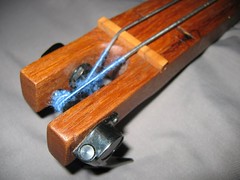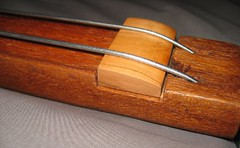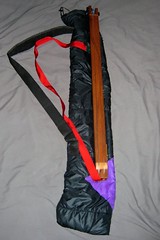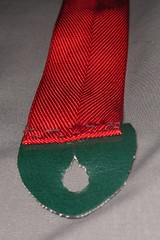
This bass was the first stringed instrument I built. I saw the Apache longbow bass, a maple fretless two-string, on the Internet and decided that making something similar looked like a worthwhile project. Because there are only two strings and a relatively thick neck, there was no need for a truss rod. In addition, a fretless bass saves on the fairly complicated process of fitting frets accurately. I also liked the idea of playing a very simple instrument that would force me to concentrate on rhythm rather than elaborate chord voicings and arpeggios (my tendency when I play 5 string bass).
This photograph is a before-and-after shot: the top piece of wood is a teak plank around 1 inch thick by 4 inches wide (25 x 100mm) that has been sitting in my Grandfather's garage for around 50 years.
The bass is finished with Danish Oil, which is a simple wipe-on finish that takes around 2 hours to apply and cures overnight. It gives a great, matte finish that is very warm and brings out the colour and grain of the teak.
The neck is slightly rounded, but basically still plank-shaped, and much thicker than a conventional bass guitar.
Position markers were cut from signwriting vinyl and placed according to the fret calculator on the Experimental Musical Instruments website.
The strap pin is attached to the neck near the top of the neck at the fifth fret position.
 The head uses Gotoh tuners (along with the strap pins and strings, the only components of the instrument that come from a music shop). This photo shows how there is good downforce on the nut (which is incidentally held in place by friction as I haven't got around to gluing it down yet).
The head uses Gotoh tuners (along with the strap pins and strings, the only components of the instrument that come from a music shop). This photo shows how there is good downforce on the nut (which is incidentally held in place by friction as I haven't got around to gluing it down yet).
 The nut and bridge are from a black cherry-plum (Prunus cerasifera nigra) from my garden. The growth rings are very close and this was a very hard piece of timber. I'm happy that it will be strong enough for the nut and bridge. The piezo pickup sits under the bridge, and this page details the construction of the concealed pickup.
The nut and bridge are from a black cherry-plum (Prunus cerasifera nigra) from my garden. The growth rings are very close and this was a very hard piece of timber. I'm happy that it will be strong enough for the nut and bridge. The piezo pickup sits under the bridge, and this page details the construction of the concealed pickup.
The piezo pickup is connected to a jack which is fitted to this control plate on the treble-side of the body. This plate is made from several layers of maple edging veneer which I laminated together using white glue and clamped under a large wooden box. I have provided space in the control cavity to add a volume control if it is necessary.
The string pass through the body and are anchored at the butt end of the plank bass with South African twenty cent coins, the best (and cheapest) ferrules I could find.
The idea of building the whole instrument myself built up a strange momentum, and by the end of it I was determined to have a home-made gig bag and strap as well.
The gig bag is cut from an old sleeping bag that had seen better days. As you can imagine, there aren't too many gig bags at a music store that fit this bass, although apparently Longbow recommend rifle bags for their basses.
The strap is made from rip-stop nylon (again courtesy of my Grandfather's garage) with the leather ends being tags from an old handbag of my Mom's, which were almost the perfect size.


















